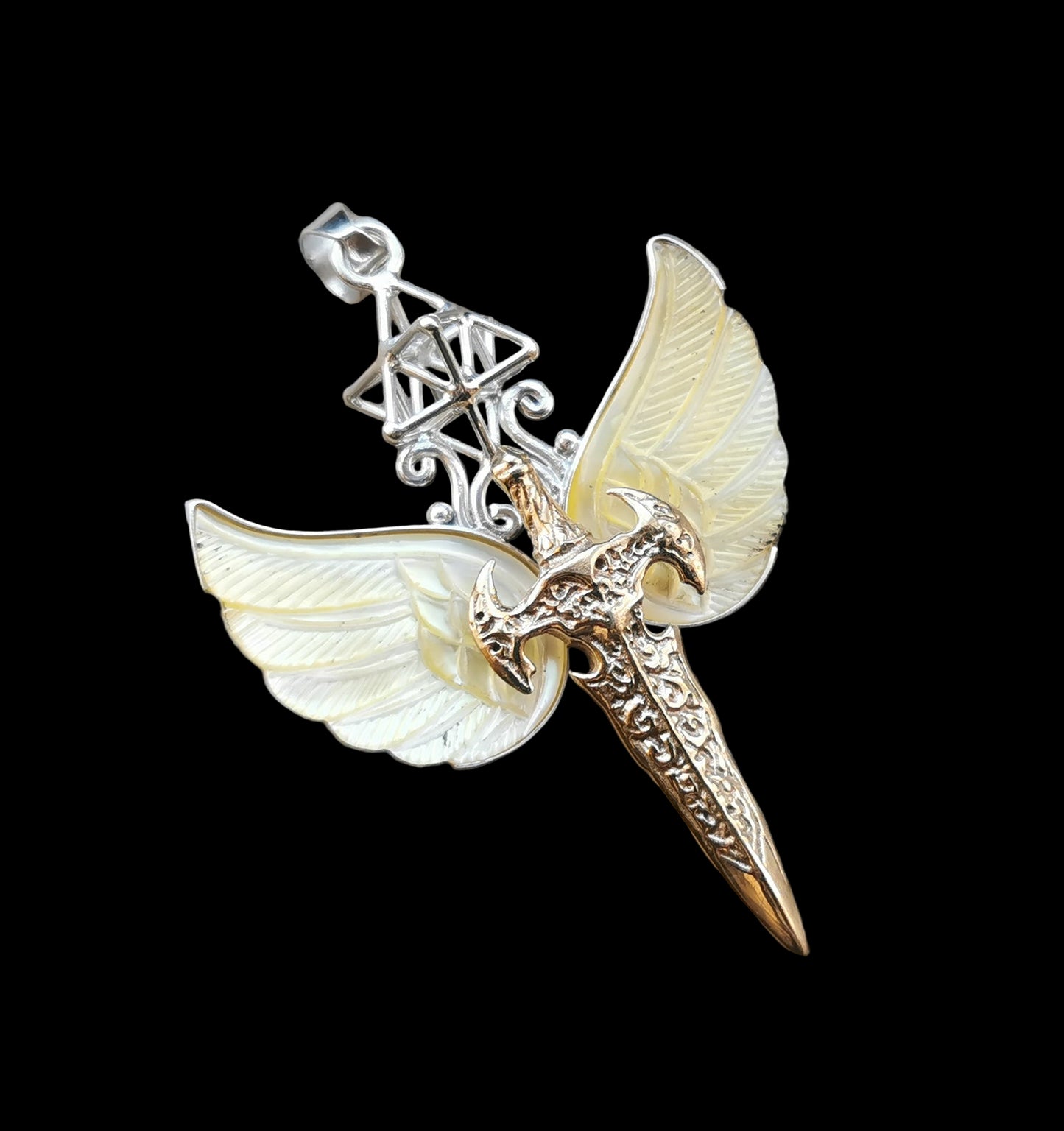Portal Glastonbury
Ref.PD1128
Ref.PD1128
Couldn't load pickup availability
Ref.PD1128 - Silver pendant with Tantric Star geometry, mother of pearl carved wings, and brass sword.
Swords hold profound symbolic significance across cultures, mythologies, and religions, often representing power, justice, honor, and duality—such as life and death or good versus evil. Their sharp blade and hilt evoke themes of cutting through illusions, protection, and transformation, making them potent emblems in folklore, art, and philosophy. Expanded interpretations draw from their historical role as weapons and tools, symbolizing human ambition, moral integrity, and the balance between creation and destruction.
### Power, Authority, and Leadership
Swords frequently symbolize authority and leadership, as they were historically wielded by rulers, warriors, and knights to enforce order or defend realms. In Western cultures, they represent sovereign power, often depicted in ceremonies like knighting, where the sword taps shoulders to confer status. Philosophically, this evokes the responsibility of power—sharp enough to protect but dangerous if misused—encouraging ethical leadership and self-discipline. In Viking traditions, swords were status symbols of wealth and prowess, buried with owners to signify eternal guardianship. Psychologically, owning or visualizing a sword can inspire confidence and assertiveness, helping individuals claim personal authority in life's battles.
### Justice, Honor, and Moral Integrity
As instruments of judgment, swords symbolize justice and honor, cutting through falsehoods to reveal truth. In many myths, they enforce moral codes, such as the samurai's katana embodying the bushido code of loyalty and discipline in Japanese culture. This duality—capable of both protection and harm—mirrors ethical dilemmas, promoting integrity and courage in decision-making. In Celtic lore, the Gaélica sword represented a warrior's identity and valor, tied to oaths of honor. Philosophically, it inspires standing firm in principles, fostering resilience against corruption or adversity.
### Duality of Life, Death, and Transformation
Swords encapsulate life's dual nature: creators of order through defense, yet bringers of death in conflict. In Eastern iconography, they appear in representations of deities, symbolizing the severing of ignorance for enlightenment, as in Hinduism or Buddhism where swords cut emotional ties or illusions. This transformative aspect encourages personal growth, where "forging" through trials builds character, akin to a blade tempered in fire. Psychologically, dreaming of swords may signal the need to confront fears or sever toxic ties, promoting renewal and empowerment.
### Wisdom, Knowledge, and Spiritual Insight
Beyond physical might, swords symbolize intellectual sharpness and wisdom, "cutting" to the core of knowledge. In Chinese culture, the jian sword represents the scholar-warrior ideal, blending intellect with action for prosperity and harmony. Ornaments on swords often signify luck, longevity, and wealth, tying to philosophical pursuits of balanced living. This fosters a mindset of enlightened action, where wisdom guides power, inspiring lifelong learning and insightful problem-solving.
Overall, swords invite contemplation of balanced power, ethical resilience, and transformative duality, serving as timeless meta
Wings are often imbued with profound meaning:
- Spiritual Transcendence: Wings symbolize the soul's journey towards higher consciousness or enlightenment, representing the aspiration to rise above the mundane or material world.
- Freedom: They signify liberation from earthly constraints, whether those are physical, emotional, or spiritual bonds.
- Protection: Often seen as a sign of spiritual protection, offering comfort and a sense of safety on one's spiritual path.
- Transformation: Like the metamorphosis of a caterpillar into a butterfly, wings represent personal transformation, rebirth, or the shedding of old ways to embrace new growth.
- Connection Between Worlds: Wings can symbolize the ability to move between different realms or states of existence, bridging the earthly with the spiritual, the known with the unknown.
- Empowerment: They embody the idea of gaining strength or power, often related to overcoming challenges or achieving personal empowerment.
- Healing: In some interpretations, wings are associated with healing energies, suggesting the capacity to heal oneself or others through spiritual means.
- Manifestation: The act of spreading wings can be seen as a metaphor for manifesting one's dreams or desires, taking flight towards one's goals.
- Intuition and Insight: Wings might also represent heightened intuition or insight, the ability to 'fly' above situations for a broader perspective.
These symbols encourage individuals to seek personal growth, embrace change, and connect with their higher selves or Spirit. Wings are not just about physical flight but about the journey of the soul.
Tantric Star
Activation: Initiation, Inspiration
The Tantric Star is formed by interlocking ascending and descending tetrahedrons (see Tetrahedron). Also known as the Mer Ka Ba, the Tantric Star functions as a 3-dimensional mandala, connecting us to our centre point, a stargate into the matrix of manifest reality. It describes the energy pattern created by the electromagnetic male and female potencies of creation as they come together to conceive atoms, Humans, the Universe - the seminal form that Consciousness takes as it initiates the polarisation of the Monad into the sacred enclosure of the Trinity, holding the frequency of the 3rd dimension fully manifest in form.
This form protects against unbalanced magnetic emanations, e.g., mobile and cordless phones. With the addition of a circle around the form, it also protects against electric emanations.
Size: 66mm/2.6in approx.


